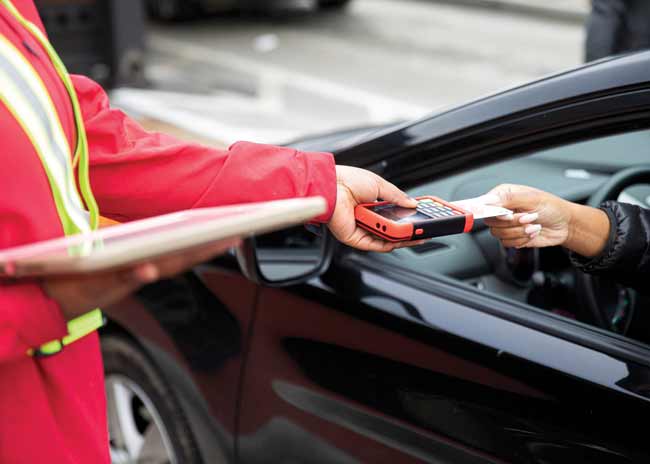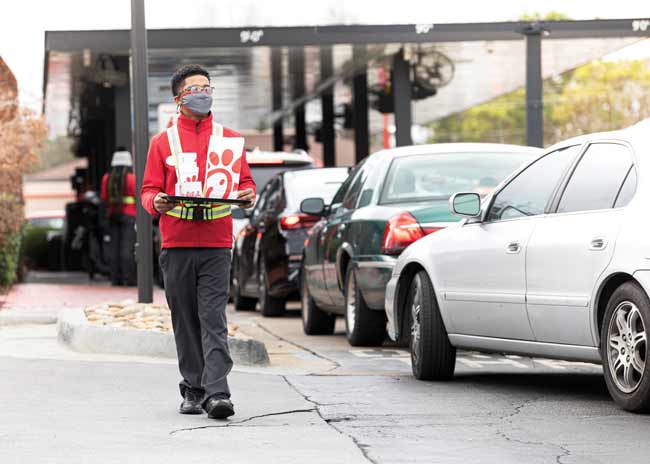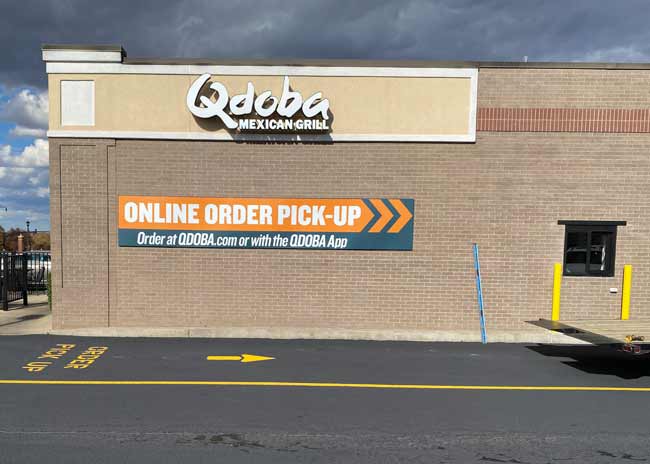Before the COVID-19 pandemic, QDOBA Mexican Grill would not even consider adding drive-thru service to its establishments. The chief reason: customer perception. Drive-thrus were associated with fast food and QDOBA positioned itself as a cut above fast-food chains, explains Jim Sullivan, QDOBA’s chief development officer.
 Mobile payment technology speeds service on the Chick-fil-A drive-thru. Image courtesy of Chick-fil-ABut when the pandemic struck and lockdowns went into effect, QDOBA, along with many other restaurants, reconsidered how to best get their fare to customers who could no longer dine in and were wary of entering public spaces. While curbside pickup was quickly embraced by customers, the prospect of drive-thru service, another way to efficiently serve take-out, was suddenly on the table at QDOBA headquarters. Customers wanted convenient options to order and buy restaurant fare from all types of establishments and drive-thru was making more sense for all quick-service brands. The perceived fast-food stigma was fading as convenience borne of necessity took precedence.
Mobile payment technology speeds service on the Chick-fil-A drive-thru. Image courtesy of Chick-fil-ABut when the pandemic struck and lockdowns went into effect, QDOBA, along with many other restaurants, reconsidered how to best get their fare to customers who could no longer dine in and were wary of entering public spaces. While curbside pickup was quickly embraced by customers, the prospect of drive-thru service, another way to efficiently serve take-out, was suddenly on the table at QDOBA headquarters. Customers wanted convenient options to order and buy restaurant fare from all types of establishments and drive-thru was making more sense for all quick-service brands. The perceived fast-food stigma was fading as convenience borne of necessity took precedence.
In the ensuing two-plus years, QDOBA, spearheaded by a few franchisees, has rolled out drive-thru at select locations. Where the new convenience was added, it has been a hit with customers, Sullivan says. “We’re getting about 20% of our revenue from drive-thrus,” he says. There’s no turning back now, as drive-thru is fair game for all the chain’s new sites and major renovation projects.
Indeed, the COVID-19 pandemic sparked a reimagining of drive-thrus across the industry. Brands that always offered drive-thru service had to modify operations to cope with a spike in demand. The growing ranks of customers opting for drive-thru demanded more efficient practices.
Chains such as Chick-fil-A upped their drive-thru game and continue to tinker with drive-thru design and procedures. The chain has built full-scale drive-thru mockups at its Atlanta headquarters using real cars and real customers to test new features. Chick-fil-A and QBOBA are among those across the industry employing technology used by both customers and restaurant personnel to create new possibilities for speedier service and more accurate order fulfillment in the drive-thru.
 A team member on the Chick-fil-A drive-thru uses a tablet computer to place orders for guests. Image courtesy of Chick-fil-A
A team member on the Chick-fil-A drive-thru uses a tablet computer to place orders for guests. Image courtesy of Chick-fil-A
Technological possibilities
During the pandemic, Chick-fil-A added extra drive-thru lanes and expanded order-taking in the drive-thru by posting employees equipped with tablet computers alongside the line of vehicles. In 2022, select Chick-fil-A sites tested a new express drive-thru lane for mobile orders. Customers place their orders via a mobile app and can bypass the normal drive-thru lane to pick up their order.
“We see this as a way to serve customers more effectively and give them more control over their experience,” says Jonathan Lassiter, a senior integration leader on Chick-fil-A’s Service and Hospitality team. “The lengthiest part of our drive-thru ordering process is the brief wait to get your order taken. The express lane cuts down ordering and payment time significantly.” Testing of the new dedicated mobile service has been successful, decreasing the wait time significantly, Chick-fil-A says. Most guests that have used the express drive-thru lane opted for it again on their next visit.
Extensive testing of such new services is essential to learn how the technology holds up to real-world conditions, how staff can best utilize the technology, and how the new feature impacts back-of-the-house operations. Does the new mobile service, for example, hamper efficiency for the normal drive-thru lane or dine-in customers?
As QDOBA ramped up curbside and drive-thru service along with growth in third-party delivery, it retrofitted all locations, adding a second makeline to ensure efficient service for all customers. The added makeline is dedicated to all digital and drive-thru orders. Located behind the dine-in makeline, the second makeline is laid out parallel to and in a mirror-image to the primary one. Each well or station is directly opposite from the corresponding one on the other line, making for efficient distribution of ingredients from the prep area. In this way, cooks moving from the prep area in the back of the house can step directly across the space between the lines to distribute each ingredient. They don’t have to move diagonally, reducing the number of steps they need to take and the opportunity to bump into or interfere with associates on the makelines.
 The pandemic prompted QDOBA to add drive-thrus for the first time. Image courtesy of QDOBA
The pandemic prompted QDOBA to add drive-thrus for the first time. Image courtesy of QDOBA
Getting orders right
With multiple options for distribution — curbside, drive-thru and delivery — accurate tracking of each order becomes more important. Digital screen displays are more effective than old-fashioned paper tickets for following progress of orders and ensuring they get distributed through the right channels, Sullivan emphasizes. Paper tickets can get misplaced, causing botched orders. Digital display systems do require considerable investment, Sullivan says, and were the chain’s biggest investment for its drive-thru initiative.
In service of accurate order fulfillment, QDOBA installed a digital menu board at the exterior drive-thru order station. Adjacent to two static boards that display the restaurant’s menu, the digital screen serves as an order confirmation medium. After speaking their choices to an associate inside, the confirmation board spells out the order in detail, including all the ingredients of the burrito or bowl.
Associates inside at the makeline hear the order being placed so that they can immediately start compiling it. The digital board inside allows them to easily check the order for accuracy. QDOBA’s extensive ingredient choices makes order fulfillment challenging even with the digital boards and the brand is investigating the addition of mobile ordering for drive-thru. Mobile apps can generate a distinct order number for each customer, Sullivan says, improving efficiency and accuracy. Currently, customers can place web orders for pickup but not drive-thru.
QDOBA’s wide range of choices presents a challenge for drive-thru. “A regular user knows exactly what we offer and can place their orders quickly,” Sullivan notes, but those unfamiliar with the chain’s fare take longer to decide on what ingredients they want. That can slow the line. One possible option to speed flow of the car stack is to post QR codes online and on exterior signage for specific menu choices. It might not be practical for QDOBA, with its wide range of ingredient options, to adopt that feature, but Sullivan posits that the chain might use QR technology in the future to support special promotions.
Basic principles
Multiple design features work together to create an efficient drive-thru, whether the latest tech gadgets are employed or not. Prominent, easy-to-discern wayfinding is a crucial element. Customers should be able to readily identify where to queue up for the drive-thru line as they enter the property. Signs, along with striping and messaging on pavement, and strategically placed curbing point drivers where they need to go.
QDOBA has placed large, brightly colored signage on the building along with free-standing signs at sites offering drive-thru. These visual cues are hard to miss and proclaim the new drive-thru service to customers who may not otherwise know it is available.
The average number of cars in a queue at peak times is a key concern. Local permitting governs the length of the car stack, as local officials (as well as restaurant owners) want to avoid having vehicles backed up onto the street. Space on-site for a car stack of five-to-seven vehicles is typical, Sullivan says. One QDOBA site in the Denver area can accommodate as many as 15 vehicles, he notes. “But we don’t want that,” he says. “It gives the wrong impression.” Too long of a line suggests a long wait for an order. Therefore, the brand must continue to monitor its service efficiency and make improvements so that car stacks don’t lengthen beyond a half-dozen vehicles.
When planning for drive-thru service, brands have a choice of installing one or two drive-up windows. Brands with high drive-thru volumes such as Dunkin’, which realizes the lion’s share of orders via drive-thru, often employ two windows. The first window is typically used for the customer to make a payment and the second is dedicated to handing the customer the order. At off-peak times, the store might close one window, and both collect payment and distribute orders at one window. “Even businesses with heavy drive-thru traffic find that it is not efficient to run a second window off-peak from a labor standpoint,” Sullivan says. QDOBA is among many brands that has opted to install just one window, an appropriate choice for its volume of peak business.
For some brands that were reluctant to adopt drive-thru, the pandemic has changed the environment as customers now expect multiple venue choices to order and obtain restaurant fare. “Post-pandemic, we are seeing more guests dining in-house, but drive-thru business has remained constant,” Sullivan says. Drive-thru is now part of the strategic plan and there’s no reason to think that will change. Not only does it boost customer service, but it also “allows us to be more square-foot efficient,” Sullivan says. The dual benefits have been compelling enough to overcome the old drive-thru stigma.



